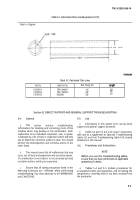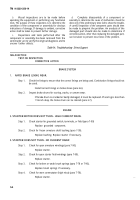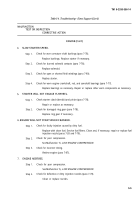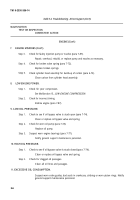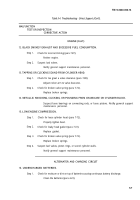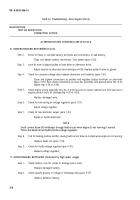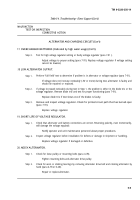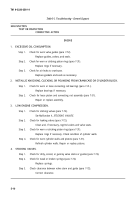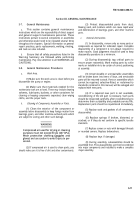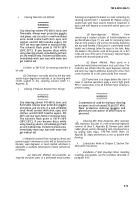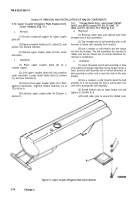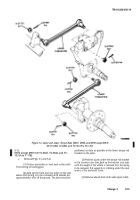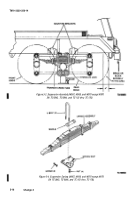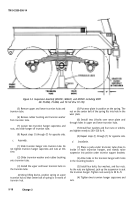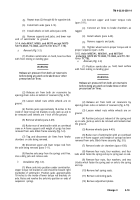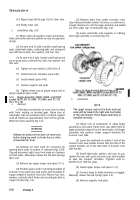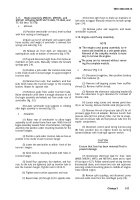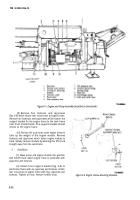TM-9-2330-356-14
SEMITRAILER, TANK: 5000 GALLON, BULK HAUL, SELF LOAD/UNLOAD M967 AND M967A1; SEMITRAILER, TANK: 5000 GALLON, FUEL DISPENSING, AUTOMOTIVE M969 AND M969A1; SEMITRAILER, TANK: 5000 GALLON, FUEL DISPENSING, UNDER/OVERWING AIRCRAFT M970 AND M970A1
TECHNICAL MANUAL; OPERATOR’S, UNIT, DIRECT SUPPORT, AND GENERAL SUPPORT MAINTENANCE MANUAL
OCTOBER 1990
TM-9-2330-356-14 - Page 321 of 528
TM 9-2330-356-14
e.
Cleaning Materials and Methods.
WARNING
Dry cleaning solvent P-D-680 is toxic and
flammable. Always wear protective goggles
and gloves, and use only in a well-ventliated
area. Avoid contact with skin, eyes, and
clothes, and DO NOT breathe vapors. DO
NOT use near open flame or excessive heat.
The solvent’s flash point Is 100°F-138°F
(38°C-59°C). If you become dizzy while
using cleaning solvent, immediately get fresh
air and medical help. if solvent contacts eyes,
Immediately wash your eyes with water and
get medical aid.
(1) Refer to TM 9-247 for cleaning materials to
be used.
(2) Cleaning is normally done by the dip-tank
and/or vapor-degreaser methods, or by cleaning with
cloths soaked in dry cleaning solvent (item 11,
Appendix E).
f.
Cleaning of Material Received From Storage.
WARNING
Dry cleaning solvent P-D-680 Is toxic and
flammable. Always wear protective goggles
and gloves, and use only in a weii-ventilated
area. Avoid contact with skin, eyes, and
clothes, and DO NOT breathe vapors. DO
NOT use near open flame or excessive heat.
The solvent’s flash point is 100°F-138°F
(38°C-59°C). if you become dizzy while
using cleaning solvent, immediately get fresh
air and medical help. If solvent contacts eyes,
immediately wash your eyes with water and
get medical aid.
(1) Material received from storage by direct and
general support maintenance units will be cleaned by the
dip-tank, vapor-degreaser, or steam method; whichever is
applicable or available. Descriptions of these methods are
as follows:
(a) Dip-tank Method.
Disassemble as
required and place parts in a perforated metal basket.
Submerge and agitate the basket in a tank containing dry
cleaning solvent (item 11, Appendix E). Repeat, using a
second tank with clean solvent. Extent of treatment in
each tank will depend on ease with which parts are
cleaned.
(b) Vapor-degreaser
Method.
Tanks
containing a heated solution of trichlorethylene or
perchlorethylene (type 11) are used for decreasing items
that are very greasy or oily and are not readily cleaned by
the dip-tank method. Place parts in a perforated metal
basket and submerge below the vapor in the tank. Keep
the basket in this position until all the grease, oil, or dirt
melts and runs off the parts. If necessary, material maybe
washed with decreasing spray unit.
(c)
Steam Method.
Place parts in a
perforated metal basket and steam treat until clean. This
method is less efficient than the vapor-degreaser method,
and parts may require additional cleaning to remove final
traces of grease, oil or dirt, particularity from recesses.
(2) If
some time is to elapse before the start of
repair or overhaul operations, apply a coat of light grade
PE-10
preservative oil to all finished metal surfaces to
prevent rusting.
WARNING
Compressed air used for drying or cleaning
purposes must not exceed 30 psi (207 kPa).
Wear protective clothing (goggles and
gloves) and use caution to avoid injury to
personnel.
g.
Cleaning After Shop Inspection.
After inprocess
shop inspections, dip parts in a tank containing fingerprint
remover oil (item 9, Appendix E). Remove parts (with
rubber gloves), and dry thoroughly with compressed air or
by wiping with clean,
lint-free cloths (item 24,
Appendix E). Apply preservatives as soon as possible after
cleaning.
h.
Lubrication.
Refer to Chapter 3, Section I for
lubrication instructions.
i.
Installation of Split Couplings.
When installing
couplings and gaskets, use the procedure described in
paragraph 4-85.
5-13
Back to Top

